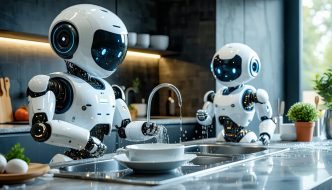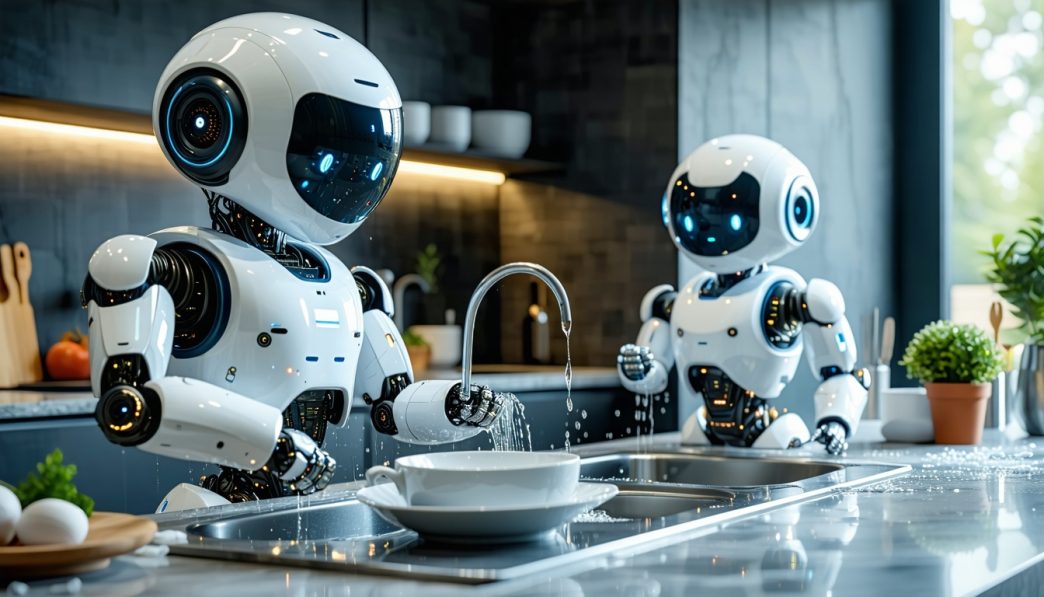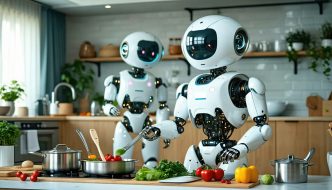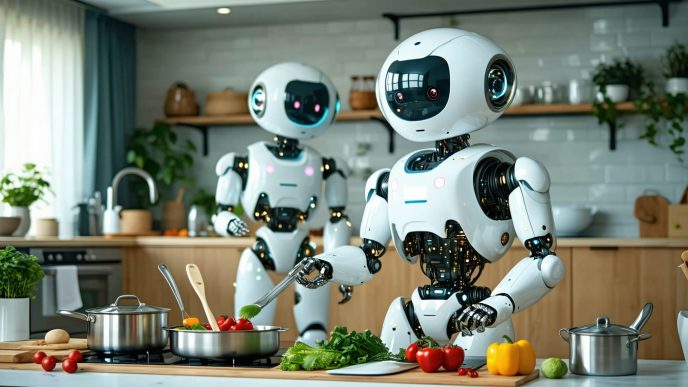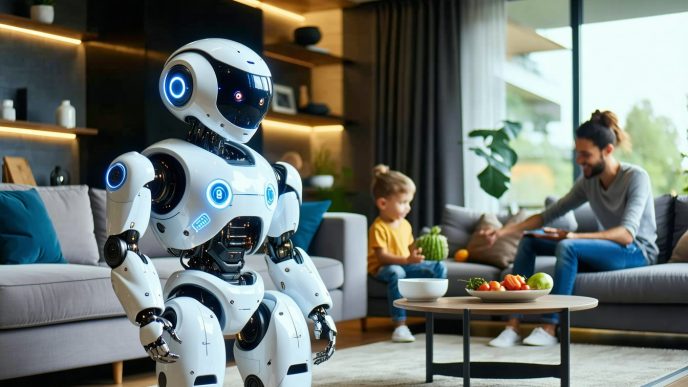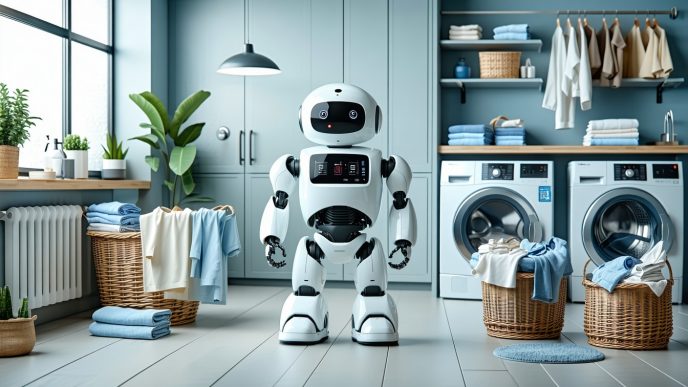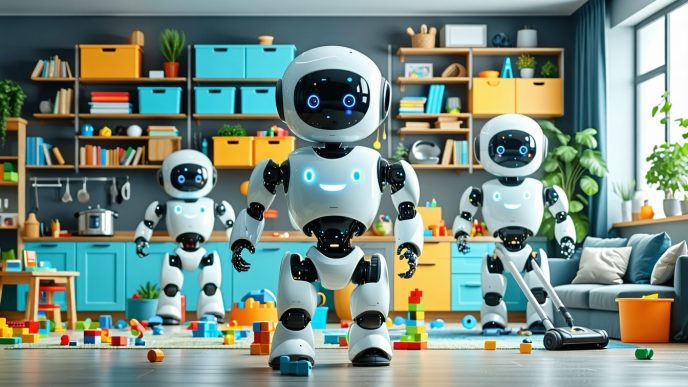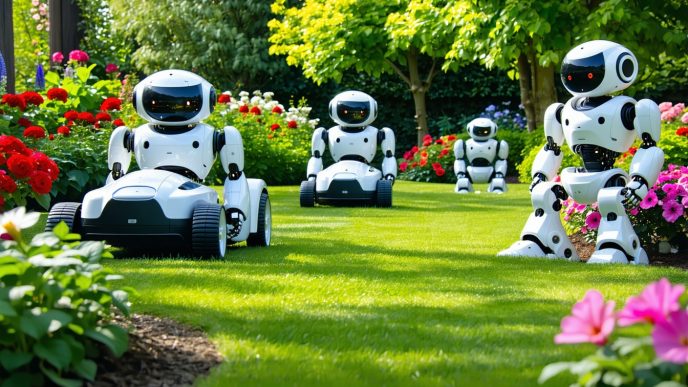The Rise of Robotics in the Kitchen
The integration of robotics into the kitchen has seen significant advances in recent years. These advancements are transforming the way families and busy professionals manage their household tasks, improving efficiency and freeing up valuable time.
Advancements in Household Robotics
The field of household robotics has progressed rapidly, leading to the development of increasingly sophisticated machines designed for kitchen use. From autonomous vacuum cleaners to robots specifically designed for cooking and cleaning, innovations have made tasks easier than ever before. Some of the recent enhancements include:
| Technology Feature | Description |
|---|---|
| Smart Sensors | Enable robots to navigate obstacles and detect when tasks are complete. |
| Machine Learning | Allows robots to learn from user preferences and adapt to different environments. |
| Voice Control | Integration with smart assistants enables hands-free operation and scheduling. |
| Connectivity | Robots can connect to smartphones and other devices for remote monitoring and control. |
These advancements not only provide convenience but also help streamline daily chores in the kitchen.
Impact of Robotics on Daily Chores
The impact of robotics on everyday kitchen duties is profound. With automated solutions, families can reduce the time spent on repetitive tasks, allowing them to focus on more meaningful activities. For instance, robots for dishwashing and kitchen cleaning can take over these time-consuming chores, offering significant time savings.
A study found that homeowners could reclaim an average of 5-7 hours per week by utilizing household task robots, such as dishwashers and kitchen cleaning devices.
| Task | Time Spent (Hours/Week) | Potential Time Saved (Hours/Week) |
|---|---|---|
| Dishwashing | 3-4 | 3 |
| Kitchen Cleaning | 2-3 | 2 |
| Meal Preparation | 6-8 | 2-3 |
The rising efficiency provided by these robots not only enhances daily living but also contributes to smoother household management. Busy professionals can use this freed time for relaxation, family activities, or pursuing personal interests, accentuating the benefits of incorporating robotics into their lives.
As the technology continues to evolve, the potential for robots assisting with additional tasks, such as laundry assistance and gardening, becomes increasingly promising. The future of household automation looks bright, providing families and individuals with tools to improve their quality of life. For further insights on this topic, explore our article on the future of household automation.
Current Challenges in Kitchen Chores
Managing kitchen chores can be a significant challenge for families, homeowners, and busy professionals. Various tasks demand substantial time and effort, making automation a desirable solution.
Time-Consuming Tasks
Many kitchen responsibilities consume valuable time that individuals could spend on other activities. Cooking, cleaning, and organizing can quickly add up, especially for those with hectic schedules. Here are some common time-consuming kitchen tasks:
| Task | Average Time Spent (per week) |
|---|---|
| Meal Preparation | 5 – 10 hours |
| Dishwashing | 2 – 5 hours |
| Kitchen Cleaning | 1 – 3 hours |
| Grocery Shopping | 2 – 4 hours |
As seen in the table, individuals can spend several hours each week on these tasks. The introduction of robots for dishwashing and kitchen cleaning could significantly reduce this time commitment, allowing users to focus on other important aspects of their lives.
Difficulty in Managing Multiple Household Chores
In addition to time-consuming tasks, families often face the challenge of managing multiple household chores simultaneously. This can lead to feelings of overwhelm and stress as individuals try to keep up with various responsibilities. Common challenges include:
- Balancing meal prep with cleanup
- Organizing grocery shopping while cooking
- Ensuring the kitchen is clean after every meal
These overlapping tasks can strain daily schedules, making it essential to seek innovative solutions. Automation through robotics may alleviate some of this burden. By providing assistance in tasks such as dishwashing and kitchen cleaning, robots can contribute to improved efficiency.
Furthermore, integrating household task robots into daily routines can help streamline chores and create a more organized environment. For more information about the integration of technology into daily chores, check our article on household task robots.
As the demand for efficient household management grows, it’s clear that robotics will play a crucial role in transforming and simplifying kitchen chores in the future.
Future Kitchen Robots
The future of kitchen robotics promises exciting advancements aimed at alleviating the burdens associated with everyday household chores. As technology continues to evolve, kitchen robots are expected to take on various roles and tasks, further enhancing the lives of families, homeowners, and busy professionals.
Potential Roles and Tasks
Future kitchen robots are likely to have diverse roles that extend beyond basic dishwashing and cleaning. They may include:
| Role | Description |
|---|---|
| Food Preparation | Robots may assist in chopping, mixing, and cooking ingredients, streamlining meal processes. |
| Cleaning Surfaces | Robots could autonomously wipe down counters and surfaces, ensuring a clean cooking environment. |
| Organizing Inventory | Robots would keep track of kitchen supplies, suggesting grocery lists based on usage and preferences. |
| Waste Management | Robots may help in sorting waste for recycling and composting, promoting environmentally friendly practices. |
| Assisting with Cooking | Some robots could offer step-by-step guidance for recipes, helping both novice and experienced cooks. |
These potential roles highlight how robots can transform the kitchen into a more efficient and manageable space.
Design and Functionality
The design and functionality of future kitchen robots will play a critical role in their effectiveness and user acceptance. Here are some key features anticipated in these robots:
| Design Feature | Functionality |
|---|---|
| Intuitive Interfaces | Touchscreens or voice-activated controls for easy operation by users of varying ages. |
| Smart Sensors | Sensors that can detect food temperature, humidity, and cleanliness, adjusting their operations accordingly. |
| Modular Design | Robots may feature interchangeable parts for different tasks, allowing versatility and adaptability. |
| Integration with Smart Homes | Future kitchen robots are expected to connect seamlessly with smart home systems, coordinating with other appliances. This synergy will enhance overall efficiency and organization. |
| Automated Scheduling | Features for scheduling tasks, such as meal prep or cleaning, to optimize time management in busy households. Explore more about scheduling tasks for household robots. |
As families and professionals look for innovative ways to save time and reduce workloads, the development of these advanced robots will be crucial. The evolution of robots for dishwashing and kitchen cleaning is just one aspect of the broader trend towards household automation, which encompasses various tasks, as discussed in our article on household task robots.
Robots for Dishwashing
As technology continues to advance, robots for dishwashing are becoming an essential part of modern kitchens. These automated systems offer a variety of features designed to simplify the task of cleaning dishes and improve the overall efficiency in household management.
Automated Dishwashing Technologies
Automated dishwashing technology includes various innovations that enable robots to effectively clean dishes with minimal human intervention. Key developments in this area include:
- Smart Sensors: Dishwashing robots equipped with sensors can detect the type of dishes and the level of dirtiness, adjusting water pressure and detergent use accordingly.
- Intelligent Algorithms: Advanced algorithms enable robots to optimize their cleaning paths and methods, ensuring that every dish is washed thoroughly.
- Integration with Smart Homes: Many dishwashing robots can connect to smart home systems, allowing users to control them remotely and incorporate them into a larger home automation routine. For more on how household robots function within smart homes, see our article on household robots working with smart homes.
Here is a table highlighting some features of automated dishwashing technologies:
| Feature | Description |
|---|---|
| Smart Sensors | Detects dirtiness and optimizes cleaning |
| Intelligent Algorithms | Calculates the best cleaning paths |
| Remote Control | Operates via smartphone or smart devices |
Benefits of Dishwashing Robots
Implementing robots for dishwashing brings several significant advantages to busy families and homeowners. The primary benefits include:
- Time Savings: Automating dishwashing allows individuals to focus on other important tasks, freeing up valuable time for themselves and their families.
- Consistency and Thoroughness: Robots can consistently clean dishes without fatigue, ensuring that every dish meets a high cleanliness standard.
- Reduced Water Usage: Some advanced dishwashing robots utilize water-saving technologies that minimize consumption compared to hand washing and traditional dishwashers.
Below is a breakdown of the benefits of dishwashing robots:
| Benefit | Description |
|---|---|
| Time Savings | Frees up time for other activities |
| Consistency | Ensures the same level of cleanliness each time |
| Water Efficiency | Reduces water consumption during cleaning |
Dishwashing robots represent a significant step forward in household automation. By delegating this often-repetitive chore, families can enjoy more leisure time and maintain a cleaner kitchen environment. For insights on further household automation possibilities, explore our articles on household task robots and the future of household automation.
Robots for Kitchen Cleaning
As robotics technology continues to evolve, the application of robots for kitchen cleaning has become increasingly prevalent. These devices promise to alleviate the burden of tedious cleaning tasks, allowing families and busy professionals more time to focus on other activities.
Autonomous Cleaning Systems
Autonomous cleaning systems in the kitchen utilize advanced sensors and algorithms to navigate spaces effectively. These robots are equipped with features that enable them to detect obstacles, avoid stairs, and adjust their cleaning routines based on the layout of the kitchen.
Common examples of autonomous cleaning systems include floor-cleaning robots and countertop-cleaning devices. Below is a summary of various functions these robots can perform:
| Function | Description |
|---|---|
| Floor Cleaning | Vacuums and mops hardwood, tile, and carpet. |
| Surface Wiping | Cleans countertops and kitchen surfaces. |
| Trash Management | Collects and manages kitchen waste. |
| Edge Cleaning | Cleans corners and edges where debris accumulates. |
As these systems become more sophisticated, their capacity to operate autonomously increases, making them invaluable assets in maintaining a clean kitchen environment.
Advantages of Kitchen Cleaning Robots
Utilizing kitchen cleaning robots provides several notable benefits. These devices not only save time but also enhance efficiency in managing household chores.
| Advantage | Benefit |
|---|---|
| Time Savings | Reduces the amount of time spent on cleaning tasks. |
| Consistency | Ensures a uniform level of cleanliness throughout the kitchen. |
| Labor Reduction | Minimizes physical workload for family members and homeowners. |
| Integration with Smart Homes | Can operate alongside other smart devices to optimize cleaning schedules. |
Families and busy professionals can experience a significant reduction in their daily cleaning burden through the implementation of robots in their kitchens. For further insights into how robots can be utilized for various household tasks, explore our article on household task robots.
Enhancing Daily Living with Robotics
As robots become increasingly integrated into daily household tasks, their impact on family life and home management is significant. Two major benefits of incorporating robotic systems into the kitchen relate to time-saving advantages and improved efficiency in handling chores.
Time-Saving Benefits
Time is a precious resource for families and busy professionals alike. Robots designed for dishwashing and kitchen cleaning can significantly reduce the amount of time spent on these daily chores. By automating repetitive tasks, household members can focus on more meaningful activities, such as spending time with family or pursuing hobbies.
The following table illustrates average time savings when utilizing robots for common kitchen tasks:
| Task | Traditional Time (min) | Time with Robots (min) | Time Saved (min) |
|---|---|---|---|
| Dishwashing | 30 | 5 | 25 |
| Kitchen Cleaning | 60 | 20 | 40 |
| Food Preparation | 45 | 15 | 30 |
These robots not only perform tasks efficiently but also work consistently, allowing households to maintain cleanliness even during busy days.
Improved Efficiency in Household Management
Incorporating robots into kitchen chores leads to greater overall efficiency. Automation allows for multitasking and better organization of household tasks. Robots can handle routine chores such as dishwashing and cleaning floors while family members focus on other responsibilities.
For instance, when a robotic kitchen cleaner operates, it can coordinate with other household systems. Scheduling can be easily managed through smart home integration, ensuring that tasks are completed effortlessly. This synergy is vital for enhancing overall household productivity. For more information on scheduling tasks with robots, see our article on scheduling tasks for household robots.
Each robot can be designated a specific role, allowing for a streamlined approach to home management. Homeowners benefit from the precision of automated systems, whether they are using robots for cleaning floors, robots for laundry assistance, or robots assisting with organizing and tidying.
As families adapt to evolving technologies, the future of household automation looks promising. For more insights, refer to our article on the future of household automation. Through the effective use of robots, households can improve their daily living, saving time and enhancing efficiency.

